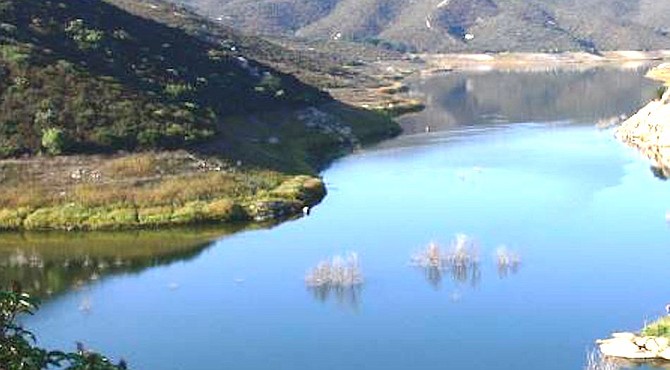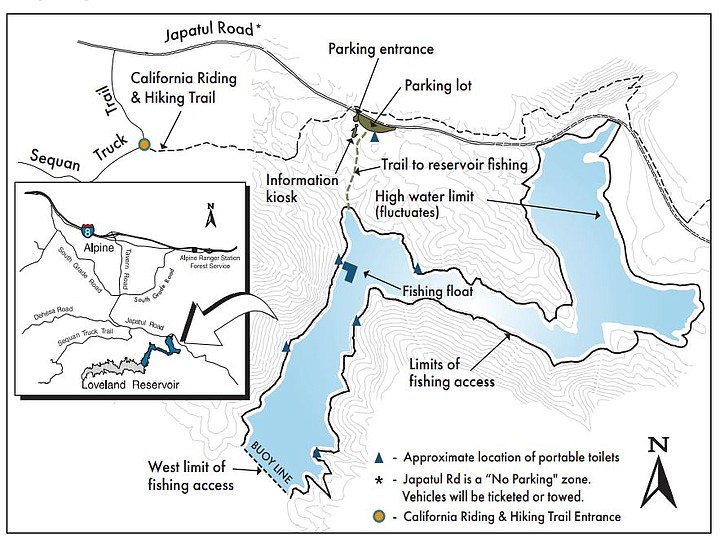 Facebook
Facebook
 X
X
 Instagram
Instagram
 TikTok
TikTok
 Youtube
Youtube

During the pandemic, open days at the county's 24 reservoirs were slashed, prompting a petition to restore the only water access available to many backcountry residents without a long drive.
Last November, the county agreed to explore ways to work with local water agencies to support public recreation at the reservoirs, which besides storing water provide fishing, boating, hiking.
As part of that effort, spearheaded by supervisor Joel Anderson, the county released a survey this month to find out what changes residents would like to see in their reservoirs to expand outdoor access.

Perhaps the most fought over is Loveland Reservoir in Alpine where anglers say fishing has been hit hard - less by drought or pandemic closures but more by hoarding by Sweetwater Authority, the public water agency that provides water to National City, Chula Vista, and Bonita.
"I can prove the water level should be higher," says Russell Walsh, a fisherman who is fighting for full access to the only free fishing reservoir, an amenity bestowed by the federal government in a land swap 25 years ago.
Loveland is currently open for fishing during temporary hours, Friday-Monday, 7 am to 3 pm. That's far from the hours of sunrise to sunset called for by an easement the water agency granted to the U.S. Forest Service in 1996.
Walsh has started his own petition, calling for adherence to the easement's sunrise-to-sunset public access. "It can help us get the water levels back."
The original fishing area, Government Cove, didn't offer the best fishing, a situation remedied by the land exchange, which swapped 1,550 acres of federal land around the reservoir for 866 acres near Descanso.

No boats were allowed, but shoreline fishing and hiking weren't optional amenities the authority could ignore at its man-made lake, which is used for emergency water storage.
A partnership between the authority and U.S. Forest Service provided public fishing access along a portion of the eastern shoreline that extends up to five miles when the reservoir is full. Years later, a floating dock, portable restrooms and a parking lot up the hill were added.
The agreement conserved habitat and public recreation. But the dock ended up stranded in mud. Today, the fishing program is under threat, which was predicted back when the land swap took place.
Correspondence in 1996 from the Department of Fish & Wildlife warned of future threats to the fishing program due to low water levels, and how the authority might manage transfers.
The state’s reservoirs bank water in wet years to help shore up the dry ones. Increasingly dry winters have led to what anglers say is more pinching of water from Loveland.
Sweetwater Authority says the transfers save ratepayers money, and it's cheaper than importing water. "Utilizing water from Loveland Reservoir and taking advantage of our assets helps us to offset the cost of purchasing water."
The agency's budget is funded not by tax revenue, but sources such as ratepayer fees.
But Walsh says they claimed anglers would have fishing from the pier year-round because it was in the "minimum pool," which varies from about 1300 to 1355 feet above mean sea level
In the years before fishing was relocated, during the worst drought, the water was 1300 feet he says, and the Descanso ranger had promised 3.6-5 miles of shoreline even at the lowest.
"Loveland is extremely drought resistant," Walsh says. And regional emergency water storage "increased tremendously with the increase in dam height at San Vicente Reservoir."
Every so often, the authority conducts a big controlled water transfer from Loveland to its Sweetwater Reservoir, about 17 miles downstream, to serve roughly 200,000 customers.
Fishing, of course, dries up.
Most recent was in January 2021, when they captured 2.7 billion gallons, said to provide enough water to last through 2022.
"You may need to hike into the reservoir further than usual," their web page notes.
Walsh says only about one mile of shoreline is currently fishable. Only three of the four porta-potties are open. Yet even with the diminished hours, attendance is high, 20-30 or more people a day.
To bring attention to the plight of the fishing program, he has sought help from the Forest Service, who told him Sweetwater Authority holds jurisdiction over the program. Attempts to get answers from other agencies and officials have gone nowhere.
Now, he and fellow anglers are hoping the board of supervisors will step in, perhaps making Loveland a county operation.


During the pandemic, open days at the county's 24 reservoirs were slashed, prompting a petition to restore the only water access available to many backcountry residents without a long drive.
Last November, the county agreed to explore ways to work with local water agencies to support public recreation at the reservoirs, which besides storing water provide fishing, boating, hiking.
As part of that effort, spearheaded by supervisor Joel Anderson, the county released a survey this month to find out what changes residents would like to see in their reservoirs to expand outdoor access.

Perhaps the most fought over is Loveland Reservoir in Alpine where anglers say fishing has been hit hard - less by drought or pandemic closures but more by hoarding by Sweetwater Authority, the public water agency that provides water to National City, Chula Vista, and Bonita.
"I can prove the water level should be higher," says Russell Walsh, a fisherman who is fighting for full access to the only free fishing reservoir, an amenity bestowed by the federal government in a land swap 25 years ago.
Loveland is currently open for fishing during temporary hours, Friday-Monday, 7 am to 3 pm. That's far from the hours of sunrise to sunset called for by an easement the water agency granted to the U.S. Forest Service in 1996.
Walsh has started his own petition, calling for adherence to the easement's sunrise-to-sunset public access. "It can help us get the water levels back."
The original fishing area, Government Cove, didn't offer the best fishing, a situation remedied by the land exchange, which swapped 1,550 acres of federal land around the reservoir for 866 acres near Descanso.

No boats were allowed, but shoreline fishing and hiking weren't optional amenities the authority could ignore at its man-made lake, which is used for emergency water storage.
A partnership between the authority and U.S. Forest Service provided public fishing access along a portion of the eastern shoreline that extends up to five miles when the reservoir is full. Years later, a floating dock, portable restrooms and a parking lot up the hill were added.
The agreement conserved habitat and public recreation. But the dock ended up stranded in mud. Today, the fishing program is under threat, which was predicted back when the land swap took place.
Correspondence in 1996 from the Department of Fish & Wildlife warned of future threats to the fishing program due to low water levels, and how the authority might manage transfers.
The state’s reservoirs bank water in wet years to help shore up the dry ones. Increasingly dry winters have led to what anglers say is more pinching of water from Loveland.
Sweetwater Authority says the transfers save ratepayers money, and it's cheaper than importing water. "Utilizing water from Loveland Reservoir and taking advantage of our assets helps us to offset the cost of purchasing water."
The agency's budget is funded not by tax revenue, but sources such as ratepayer fees.
But Walsh says they claimed anglers would have fishing from the pier year-round because it was in the "minimum pool," which varies from about 1300 to 1355 feet above mean sea level
In the years before fishing was relocated, during the worst drought, the water was 1300 feet he says, and the Descanso ranger had promised 3.6-5 miles of shoreline even at the lowest.
"Loveland is extremely drought resistant," Walsh says. And regional emergency water storage "increased tremendously with the increase in dam height at San Vicente Reservoir."
Every so often, the authority conducts a big controlled water transfer from Loveland to its Sweetwater Reservoir, about 17 miles downstream, to serve roughly 200,000 customers.
Fishing, of course, dries up.
Most recent was in January 2021, when they captured 2.7 billion gallons, said to provide enough water to last through 2022.
"You may need to hike into the reservoir further than usual," their web page notes.
Walsh says only about one mile of shoreline is currently fishable. Only three of the four porta-potties are open. Yet even with the diminished hours, attendance is high, 20-30 or more people a day.
To bring attention to the plight of the fishing program, he has sought help from the Forest Service, who told him Sweetwater Authority holds jurisdiction over the program. Attempts to get answers from other agencies and officials have gone nowhere.
Now, he and fellow anglers are hoping the board of supervisors will step in, perhaps making Loveland a county operation.
Comments